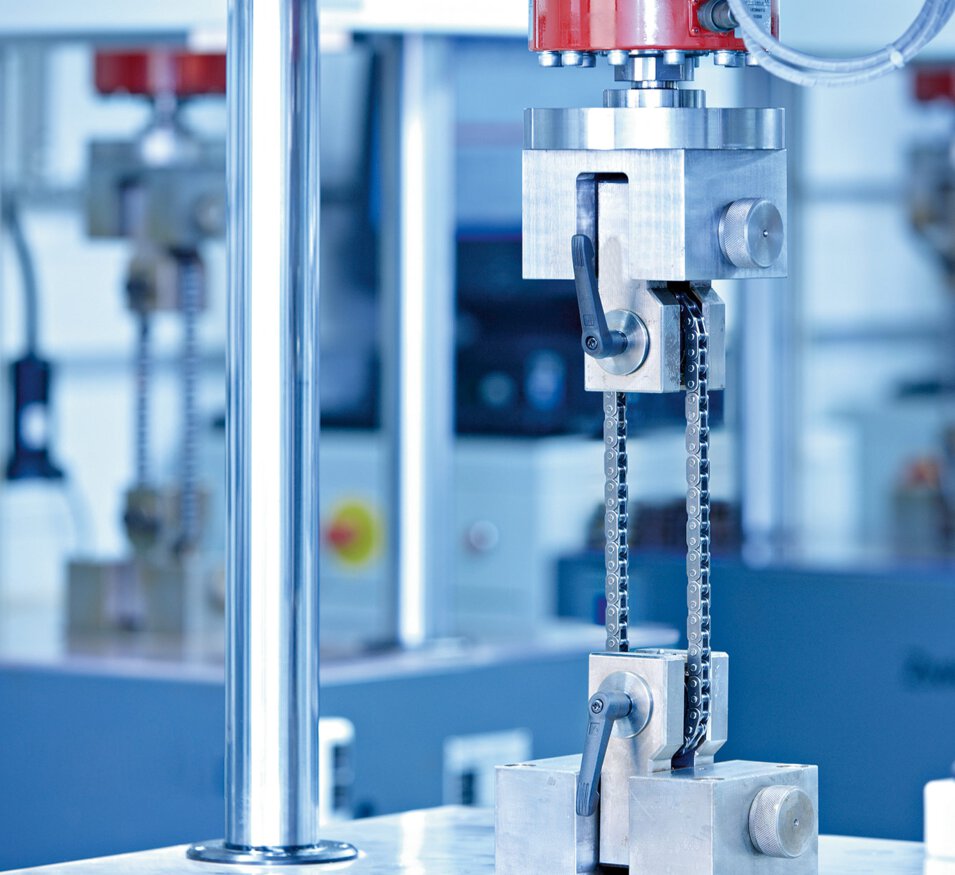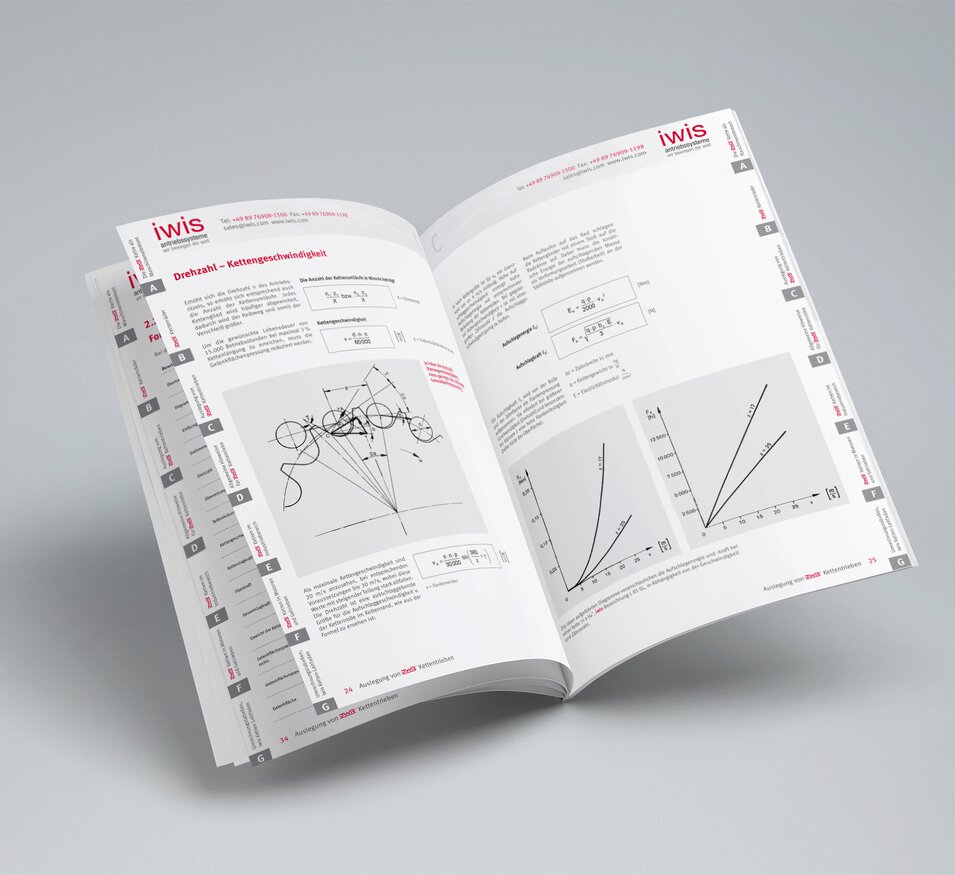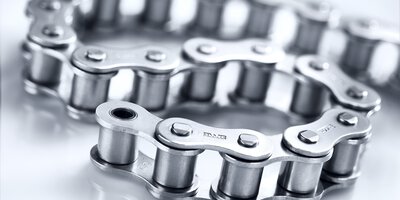Chain Engineering
Chain engineering is concerned with chain drives for power and motion transmission. A chain drive consists of at least one drive sprocket and one driven sprocket (input and output). Positive-lock power transmission is usually steered via sprockets.
Although roller chains are the most commonly used for chain drives, there is a wide range of other industrial chain types for other applications.
Find out more about our iwis product range.
iwis has one of Europe's largest R & D department for chain drive systems.
The 5 most important fundamental chain engineering terms
Tensile strength
The tensile strength of a chain is the load at which the chain will break when subjected to a quasi-static (very gradual) increase in load. Usually an inner link plate will break at the level of the eye, or a pin will shear, because the material cross-section is lowest at these points.
The ISO 606 standard for roller chain specifies a minimum tensile strength for all standard types of chain. Chains made by iwis have a significantly higher tensile strength than specified in the standard, a quality feature that provides users and design engineers with enhanced safety. Besides wear resistance and fatigue strength, tensile strength is one of the most important quality characteristics of a chain.
Tensile strength is usually determined by hanging a test specimen vertically in a universal testing machine and gradually increasing the load until the chain fails as the tension becomes too great.
When designing and dimensioning chain drives, the fatigue strength of the chain is the crucial factor in most cases. As a rule of thumb, we recommend using a safety factor of 7 in relation to the tensile strength.


Wear resistance
Along with tensile and fatigue strength, wear resistance is one of the most important quality characteristics of a chain. As a result of the relative movement between the chain pin and bush, these parts inevitably become worn, which in turn leads to elongation of the chain (increased play in the chain link).
Besides surface finish and heat treatment of the pins and bushes, the operating conditions of the chain are also crucial wear factors (tensile force, speed, temperature, lubrication, etc.).
In general, 3% wear elongation is considered to be the limit for roller chains. Under optimum conditions, a roller chain can be expected to have a service life of 15,000 operating hours before it fails due to wear elongation.
iwis chains boast excellent wear resistance because of their extremely high pin and bush production standards and high-quality initial lubrication. The measurement of wear resistance is not standardised, so iwis conducts resistance tests in accordance with its own specifications.
The length of two identical chain samples is permanently monitored on a test rig. As wear experiments can only ever be comparative, they must always be related to a reference test. To obtain meaningful findings, it is important that only one variable (e.g. lubricant) is altered between two test runs. The findings are plotted on a wear diagram which shows the elongation of the chain in percent over the entire course of the test.
Elasticity
The load-extension diagram shows the elasticity of a chain, i.e. the curve of the force beyond absolute extension (similar to a stress-strain diagram). The maximum value is approximately 50% of the tensile strength as this covers the typical range of roller chain applications.
The elasticity of chains is a particularly important quality feature in applications involving high loads and/or long chain lengths when precise positioning is required, as the elastic elongation has a major impact on precision.
The load-extension diagram is usually determined using a universal testing machine by recording the force applied and the corresponding displacement.


Chain length tolerances
Standard ISO 606 states that roller chains may have a length tolerance of +0.15%, based on the nominal length (number of links x pitch); the length tolerance for conveyor chains is even higher (up to +0.30%).
Negative length tolerances are not permissible, firstly because in some circumstances it might be impossible to install the chain on systems with fixed axle spacing, and secondly because it would cause problems where the chain meshes with the sprocket teeth.
All iwis products comply fully with this standard. On request we can also supply chains with even more restricted length tolerances.
JWIS-brand precision chains are not only available with standard tolerances, but also with the lowest possible length tolerances e.g. half the standard tolerance – or even one-third or one-sixth if desired. We can also fulfil special requests, e.g. matched chains within a given length tolerance. This accuracy demands maximum precision when manufacturing the individual parts, as well as sophisticated and ultra-precise assembly technologies.
Fatigue strength
In nearly all chain applications, every link alternates between a state of slackness and being under load, and is consequently subject to alternating load and tension forces (dynamic and periodic alternating stress). Since the stress limits for materials under dynamic and static loads vary greatly depending on their fatigue behaviour, in chain engineering it is also the fatigue strength and not simply the tensile strength that is the limiting design factor.
A roller chain can be operated in a stress range below the fatigue strength without it breaking as a result of component failure. Above the fatigue strength the chain operates in the finite life fatigue zone, that is to say it can withstand a certain number of load cycles,
but it will certainly fail eventually. The higher the load, the fewer the number of load changes (drive cycles) the chain can be subjected to.
Depending on its specification and quality, the fatigue strength of a chain is usually 15‑20% of the tensile strength. When dimensioning chain drives, we therefore recommend applying a safety factor of 7.
ISO 606 defines minimum fatigue strength values for standard roller chains. However, iwis has set its own, much higher, minimum values.
Fatigue strength is determined using a time-consuming "staircase" test as specified in ISO 15654. Each test can take up to 2 months.


